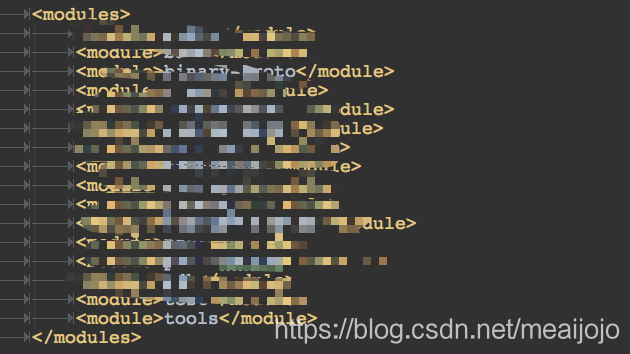使用maven-assembly-plugin如何打包多模块项目
目录
- maven-assembly-plugin打包多模块项目
- 概述
- 1. 需求
- 2. 打包流程
- 使用maven-assembly-plugin插件来定制化打包
- 使用内置的Assembly Descriptor
- 自定义Assembly Descriptor
- Assembly Plugin更多配置
maven-assembly-plugin打包多模块项目
概述
maven-assembly-plugin 是目前maven项目中最常用的打包工具,它便利、配置简单,因此可以满足我们大部分的需求。
实际开发过程中大部分Maven项目都是多模块的,因为工作需要,对其进行了研究与尝试,目前可以将多模块按照自己需求打包到一起。
1. 需求
项目本身代码非常复杂,最深可以到三层模块,即GrandFather -> Parent -> child,要求打包后的结构如下:

目录的含义不
再追溯,下面直接将打包方法。
2. 打包流程
2.1 新建打包模块
Maven多模块打包在一起时,需要新建一个专门用于打包的模块,该模块不需要有任何Java代码,只需要配置一些最终形成的环境即可。但是该模块有一个非常重要的要求: 该模块必须是整个项目最后一个进行打包的。
可以通过配置pom.xml中加载模块的顺序来控制,最后配置进入的即最后进行打包的:


本人项目比较复杂,最终配置的打包是在tools子模块下的tools-package模块中进行配置。
2.2 配置打包模块
根据最终生成的路径需求,将所有的相关路径及一些命令、配置文件等按照要求在打包模块中实现,放在resources目录即可。

注:该项目中不需要任何Java代码
2.3 配置打包模块的pom.xml
<build>
<plugins>
<plugin>
<groupId>org.apache.maven.plugins</groupId>
<artifactId>maven-assembly-plugin</artifactId>
<version>2.4.1</version>
<executions>
<execution>
<id>make-assembly</id>
<phase>package</phase>
<goals>
<goal>single</goal>
</goals>
<configuration>
<finalName>xxxxx</finalName>
<descriptors>
<descriptor>src/main/resources/assemble/assemble.xml</descriptor>
</descriptors>
</configuration>
</execution>
</executions>
</plugin>
</plugins>
</build>
2.4 配置其他模块打包方式
因为项目中使用的SpringBoot,SpringBoot也提供了一种打包方式:spring-boot-maven-plugin,这种方式打包时会将该项目中所有依赖的包(包括静态文件)统一打包至一个jar中,这个不是我们项目的需求,我们的需求是将所有的jar包(包括第三方及当前项目的jar包)都放在lib目录,且是单独存在。
因此需要将其他模块的打包配置修改,修改分为两步:
1)不再使用spring-boot-maven-plugin进行打包,即将其从pom.xml中删除;
2)在pom.xml文件中使用maven-jar-plugin进行打包,该打包如何配置请参考文章(待定)。
2.5 配置assemble.xml文件
assemble.xml文件中描述了具体如何打包,该打包过程和实际需求关系密切
<?xml version='1.0' encoding='UTF-8'?>
<assembly xmlns="http://maven.apache.org/plugins/maven-assembly-plugin/assembly/1.1.0"
xmlns:xsi="http://www.w3.org/2001/XMLSchema-instance"
xsi:schemaLocation="http://maven.apache.org/plugins/maven-assembly-plugin/assembly/1.1.0
http://maven.apache.org/xsd/assembly-1.1.0.xsd">
<id>${project.version}</id>
<formats>
<format>tar.gz</format>
</formats>
<includeBaseDirectory>true</includeBaseDirectory>
<moduleSets>
<moduleSet>
<useAllReactorProjects>true</useAllReactorProjects>
<includes>
<include>xxx.xx.x:base1</include>
<include>xxx.xx.x:base2</include>
<include>xxx.xx.x:base3</include>
<include>xxx.xx.x:base4</include>
</includes>
<binaries>
<outputDirectory>lib</outputDirectory>
<unpack>false</unpack>
</binaries>
</moduleSet>
</moduleSets>
<fileSets>
<fileSet>
<directory>src/main/resources/bin</directory>
<outputDirectory>bin</outputDirectory>
</fileSet>
<fileSet>
<directory>src/main/resources/conf</directory>
<outputDirectory>conf</outputDirectory>
</fileSet>
<fileSet>
<directory>src/main/resources/docs</directory>
<outputDirectory>docs</outputDirectory>
</fileSet><fileSet>
<directory>src/main/resources/keys</directory>
<outputDirectory>keys</outputDirectory>
</fileSet>
<fileSet>
<includes>
<include>README.md</include>
</includes>
<outputDirectory></outputDirectory>
</fileSet>
</fileSets>
<dependencySets>
<dependencySet>
<unpack>false</unpack>
<useProjectArtifact>true</useProjectArtifact>
<outputDirectory>lib</outputDirectory>
<scope>provided</scope>
</dependencySet>
<dependencySet>
<unpack>false</unpack>
<useProjectArtifact>true</useProjectArtifact>
<outputDirectory>lib</outputDirectory>
<scope>system</scope>
</dependencySet>
<dependencySet>
<unpack>false</unpack>
<useProjectArtifact>true</useProjectArtifact>
<outputDirectory>lib</outputDirectory>
<scope>runtime</scope>
</dependencySet>
</dependencySets>
</assembly>
具体的配置参数可以查看 https://maven.apache.org/plugins/maven-assembly-plugin/assembly.html
本人在实验过程中重点是处理了dependencySet这个配置:
<dependencySets>
<dependencySet>
<unpack>false</unpack>
<useProjectArtifact>true</useProjectArtifact>
<outputDirectory>lib</outputDirectory>
<scope>provided</scope>
</dependencySet>
<dependencySet>
<unpack>false</unpack>
<useProjectArtifact>true</useProjectArtifact>
<outputDirectory>lib</outputDirectory>
<scope>system</scope>
</dependencySet>
<dependencySet>
<unpack>false</unpack>
<useProjectArtifact>true</useProjectArtifact>
<outputDirectory>lib</outputDirectory>
<scope>runtime</scope>
</dependencySet>
</dependencySets>
请配置上上述三个部分,要不然总是会缺少一些依赖包打不进来,Mark一下,很重要!
使用maven-assembly-plugin插件来定制化打包
简单的说,maven-assembly-plugin 就是用来帮助打包用的,比如说打出一个什么类型的包,包里包括哪些内容等等。
目前至少支持以下打包类型:
ziptartar.gztar.bz2jardirwar
默认情况下,打jar包时,只有在类路径上的文件资源会被打包到jar中,并且文件名是${artifactId}-${version}.jar,下面看看怎么用maven-assembly-plugin插件来定制化打包。
首先需要添加插件声明:
<plugin> <groupId>org.apache.maven.plugins</groupId> <artifactId>maven-assembly-plugin</artifactId> <version>2.4</version> <executions> <execution> <!-- 绑定到package生命周期阶段上 --> <phase>package</phase> <goals> <!-- 绑定到package生命周期阶段上 --> <goal>single</goal> </goals> </execution> </executions> </plugin>
使用内置的Assembly Descriptor
要使用maven-assembly-plugin,需要指定至少一个要使用的assembly descriptor 文件。默认情况下,maven-assembly-plugin内置了几个可以用的assembly descriptor:
bin: 类似于默认打包,会将bin目录下的文件打到包中;jar-with-dependencies: 会将所有依赖都解压打包到生成物中;src:只将源码目录下的文件打包;project: 将整个project资源打包。
要查看它们的详细定义,可以到maven-assembly-plugin-2.4.jar里去看,例如对应 bin 的assembly descriptor 如下:
<assembly xmlns="http://maven.apache.org/plugins/maven-assembly-plugin/assembly/1.1.0"
xmlns:xsi="http://www.w3.org/2001/XMLSchema-instance"
xsi:schemaLocation="http://maven.apache.org/plugins/maven-assembly-plugin/assembly/1.1.0 http://maven.apache.org/xsd/assembly-1.1.0.xsd">
<id>bin</id>
<formats>
<format>tar.gz</format>
<format>tar.bz2</format>
<format>zip</format>
</formats>
<fileSets>
<fileSet>
<directory>${project.basedir}</directory>
<outputDirectory>/</outputDirectory>
<includes>
<include>README*</include>
<include>LICENSE*</include>
<include>NOTICE*</include>
</includes>
</fileSet>
<fileSet>
<directory>${project.build.directory}</directory>
<outputDirectory>/</outputDirectory>
<includes>
<include>*.jar</include>
</includes>
</fileSet>
<fileSet>
<directory>${project.build.directory}/site</directory>
<outputDirectory>docs</outputDirectory>
</fileSet>
</fileSets>
</assembly>
自定义Assembly Descriptor
一般来说,内置的assembly descriptor都不满足需求,这个时候就需要写自己的assembly descriptor的实现了。先从一个最简单的定义开始:
<?xml version='1.0' encoding='UTF-8'?>
<assembly xmlns="http://maven.apache.org/plugins/maven-assembly-plugin/assembly/1.1.0"
xmlns:xsi="http://www.w3.org/2001/XMLSchema-instance"
xsi:schemaLocation="http://maven.apache.org/plugins/maven-assembly-plugin/assembly/1.1.0
http://maven.apache.org/xsd/assembly-1.1.0.xsd">
<id>demo</id>
<formats>
<format>jar</format>
</formats>
<includeBaseDirectory>false</includeBaseDirectory>
<fileSets>
<fileSet>
<directory>${project.build.directory}/classes</directory>
<outputDirectory>/</outputDirectory>
</fileSet>
</fileSets>
</assembly>
这个定义很简单:
format:指定打包类型;includeBaseDirectory:指定是否包含打包层目录(比如finalName是output,当值为true,所有文件被放在output目录下,否则直接放在包的根目录下);fileSets:指定要包含的文件集,可以定义多个fileSet;directory:指定要包含的目录;outputDirectory:指定当前要包含的目录的目的地。
要使用这个assembly descriptor,需要如下配置:
<configuration> <finalName>demo</finalName> <descriptors> <!--描述文件路径--> <descriptor>assemblies/demo.xml</descriptor> </descriptors> <outputDirectory>output</outputDirectory> </configuration>
最后会生成一个demo-demo.jar 文件在目录 output 下,其中前一个demo来自finalName,后一个demo来自assembly descriptor中的id,其中的内容和默认的打包出来的jar类似。
如果只想有finalName,则增加配置:
<appendAssemblyId>false</appendAssemblyId>
添加文件
上面演示了添加所有编译后的资源,同样的可以增加其他资源,例如想添加当前工程目录下的某个文件 b.txt ,在assembly descriptor的assembly结点下增加
<files> <file> <source>b.txt</source> <outputDirectory>/</outputDirectory> </file> </files>
这里用到了 files 元素类型,可以想象 fileSets 下的结点都是针对文件夹的;files 下的结点都是针对文件的。
也可以改变打包后的文件名,例如上面的 b.txt ,希望打包后的名字为 b.txt.bak, 只需要在file 里添加以下配置 :
<destName>b.txt.bak</destName>
排除文件
在 fileSet 里可以使用 includes 和 excludes 来更精确的控制哪些文件要添加,哪些文件要排除。
例如要排除某个目录下所有的txt文件:
<fileSet>
<directory>${project.build.directory}/classes</directory>
<outputDirectory>/</outputDirectory>
<excludes>
<exclude>**/*.txt</exclude>
</excludes>
</fileSet>
或者某个目录下只想 .class 文件:
<fileSet>
<directory>${project.build.directory}/classes</directory>
<outputDirectory>/</outputDirectory>
<includes>
<include>**/*.class</include>
</includes>
</fileSet>
添加依赖
如果想把一些依赖库打到包里,可以用 dependencySets 元素,例如最简单的,把当前工程的所有依赖都添加到包里:
<dependencySets> <dependencySet> <outputDirectory>/</outputDirectory> </dependencySet> </dependencySets>
在assembly下添加以上配置,则当前工程的依赖和工程本身生成的jar都会被打包进来。
如果要排除工程自身生成的jar,则可以添加
<useProjectArtifact>false</useProjectArtifact>
unpack参数可以控制依赖包是否在打包进来时是否解开,例如解开所有包,添加以下配置:
<unpack>true</unpack>
和 fileSet 一样,可以使用 excludes 和 includes 来更详细的控制哪些依赖需要打包进来;另外 useProjectAttachments,useTransitiveDependencies,useTransitiveFiltering等参数可以对间接依赖、传递依赖进行控制。
其他选项
moduleSets:当有子模块时候用;repositories:想包含库的时候用;containerDescriptorHandlers:可以进行一些合并,定义ArtifactHandler之类的时候可以用,(可以参考:说明);componentDescriptors:如上所述,可以包含一些componentDescriptor定义,这些定义可以被多个assembly共享。
Assembly Plugin更多配置
上面已经看到了一些Assembly Plugin本身的配置,例如 finalName, outputDirectory, appendAssemblyId 和 descriptors 等,除了这些还有其他的一些可配置参数,参见:single,其中某些参数会覆盖在assembly descriptor 中的参数。有一个比较有用的参数是: archive,它的详细配置在:archive。
下面介绍一些archive的用法。
指定Main-Class
archive的一个重要用处就是配置生成的MANIFEST.MF文件。默认会生成一个MANIFEST.MF文件,不过这个文件默认值没什么意义。如果想指定生成jar的Main-Class,可以如下配置:
<archive> <manifest> <mainClass>demo.DemoMain</mainClass> </manifest> </archive>
下面来看一个项目中实际配置的文件:
pom文件:
<plugin>
<groupId>org.apache.maven.plugins</groupId>
<artifactId>maven-assembly-plugin</artifactId>
<version>${maven-assembly-plugin.version}</version>
<configuration>
<descriptors>
<descriptor>package.xml</descriptor>
</descriptors>
</configuration>
<executions>
<execution>
<id>make-assembly</id>
<phase>package</phase>
<goals>
<goal>single</goal>
</goals>
</execution>
</executions>
</plugin>
assembly descriptor 文件:
<assembly>
<id>${assembly-id}</id>
<!-- 最终打包成一个用于发布的war文件 -->
<formats>
<format>${assembly-format}</format>
</formats>
<fileSets>
<!-- 把项目公用的配置文件,打包进zip文件的config目录 -->
<fileSet>
<directory>${project.basedir}/src/main/resources/base</directory>
<outputDirectory>WEB-INF/classes</outputDirectory>
</fileSet>
<!-- 把项目环境的配置文件,打包进zip文件的config目录 -->
<fileSet>
<directory>${project.basedir}/src/main/resources/${env}</directory>
<outputDirectory>WEB-INF/classes</outputDirectory>
</fileSet>
<!-- 打包项目自己编译出来的jar文件 -->
<fileSet>
<directory>${project.build.directory}</directory>
<outputDirectory>WEB-INF/lib</outputDirectory>
<includes>
<include>*.jar</include>
</includes>
</fileSet>
<!-- 打包项目依赖的jar文件 -->
<fileSet>
<directory>${project.build.directory}</directory>
<outputDirectory>/</outputDirectory>
<includes>
<include>WEB-INF/lib/*.jar</include>
</includes>
</fileSet>
</fileSets>
</assembly>
以上为个人经验,希望能给大家一个参考,也希望大家多多支持我们。

